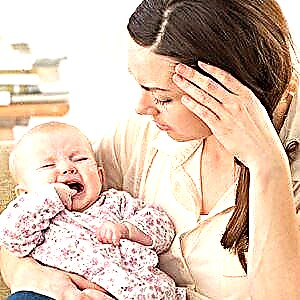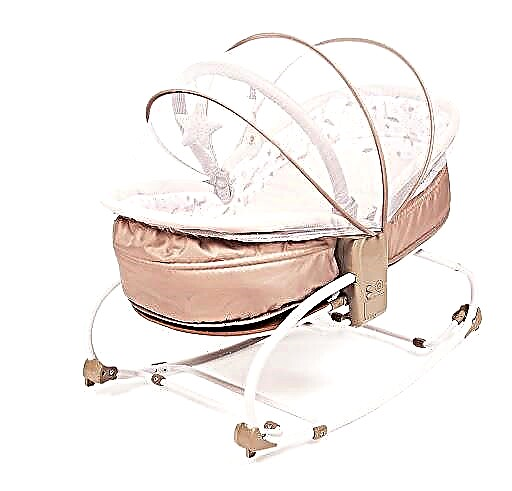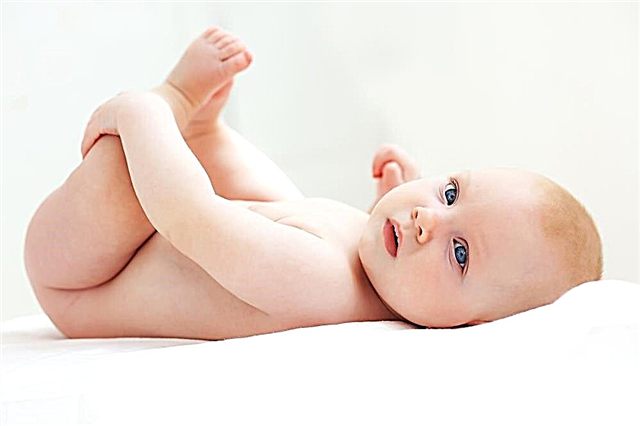For a baby who cannot speak, loud crying becomes the only opportunity to share his insoluble problems with his mother. However, even experienced parents do not always understand how to calm down a child who is constantly screaming and arching. A good tip is to keep your composure! But where to get it, if it seems that there is no reason for crying, and you can't calm the baby down? First of all, you do not need to reproach yourself, you are not a bad mom at all. It's just that you have not yet guessed about the methods that help millions of parents to rock even the most capricious babies. And if the child is calm, then mom and dad retain their composure, common sense and calmness.
Causes of baby crying
The child, while still in the womb, establishes a strong emotional connection with the mother, which helps him to catch any change in her mood.
This is why the newborn is extremely sensitive to the mother's condition. A crying child can become extra nervous when it realizes that the mother is worried, confused, feeling helpless or irritated.
Pediatricians strongly advise you to approach a crying baby in an even mood. If this is not possible (not every woman can remain calm in such an environment), it is better to ask for help from a husband or another close relative who exudes confidence.
Unlike older children, a newborn will never cry unnecessarily. There is always a reason for crying babies, even if it does not lie on the surface.
The cries and tears of an infant should not be ignored. Contrary to some beliefs, such crying is not beneficial for the lungs or tempering.
On the contrary, the incessant roar can shatter the nervous system of the crumb and undermine his trust in the world around him. Another undesirable consequence of prolonged screaming is a hernia of the navel.
Before you figure out how to calm a crying baby, you need to establish the source of children's tears. Experts identify several main reasons:
 hunger;
hunger;- temperature discomfort;
- wet diapers;
- colic;
- feeling of fear;
- boredom;
- overwork.
Initially, mothers still do not know how to establish by the nature of crying what exactly the little one wants. But after a while, different types of children's screams become distinguishable, since the volume, duration and intonation in each case will differ significantly from each other.
How to understand the cause of the screams?
Usually, the child cries because he is hungry, feels pain with colic, or something (or someone) scared him. In such cases, the newborn will cry very loudly, hysterically and without stopping.
Certain characteristics and signs will help determine which of the above factors worries the baby at the moment.
- A hungry child cries loudly enough, intensely and for a long time. If you do not immediately approach him, he will begin to choke as if. And after taking on the handles, he will immediately begin to find the nipple.
- If the cause of a child's cry is pain, then you can hear a plaintive note in it. If the pain syndrome is sudden or sharp, the child will cry loudly and very loudly.
- Is fear a prerequisite for crying? Then the baby screams hysterically, starting abruptly and ending just as unexpectedly. Usually, when he sees his mother and feels the warmth of her body, he quickly calms down.
In other situations, the child begins to call his parents with inviting cries, that is, in this way he tries to draw their attention to his problem. The kid cries a little, then stops to evaluate the parental reaction.
If the mother or father ignores the children's demands, then the screams will be repeated again and again at different time intervals. Usually, the child does not calm down until the source of the inconvenience is eliminated.
Crying due to hunger
If you still cannot determine the cause by the nature of the cry, trust your logical conclusions. With an established diet, one can already assume when the baby is hungry, and in what situations he just missed it.
 Keeping a diary of observations helps many mothers to determine the source of crying.
Keeping a diary of observations helps many mothers to determine the source of crying.
It notes when and how the baby screams, from which he calms down. If he ate a little during the previous feeding, and now woke up earlier than usual, then the feeling of hunger is to blame.
To be sure of this, there is no need to immediately give a breast or a bottle - you should try to shake the baby a little.
And here two options are possible: either he will calm down and fall asleep, or he will start sucking on his fists and looking for his mother's nipple, showing that he is hungry.
The newborn should be rocked with caution, avoiding a large range of motion. Excessive shaking is a serious health hazard for children.
An easy way to make sure your baby is eating well is to weigh him or her by tracking weight gain. After consulting a doctor, you can increase the volume of milk or formula if the child is not gaining the necessary grams well.
However, when feeding, problems may arise: the child does not calm down, but, on the contrary, starts screaming even more. It is necessary to consider in more detail the possible reasons for this behavior.
Problems feeding your baby
| Negative signs | Likely reason for this behavior | What to do for parents |
|---|---|---|
| Labored breathing | Nose clogged with secretions | Clean your nasal cavity with a baby shower head and a rubber bulb. |
| Coughs and snorts | Most likely, the baby sucks greedily and swallows a lot of milk. | Try to control the amount of milk and formula that the baby uses. For bottle feeding, you can purchase a teat with a smaller opening. |
| Crying intensifies, the baby jerks his head, pulls his arms to his ears, the skin near the ears turns red. | Inflammation of the middle ear (otitis media). It can develop due to ingestion of food in the hearing organs. | First of all, the baby needs to be shown to the doctor. He will prescribe safe ear drops and nasal (vasoconstrictor) drops. |
| The kid turns the head away. In the mouth, swollen gums, plaque is noticeable on the tongue of a white, yellow and grayish hue. | Thrush (candidiasis) or damage to the oral mucosa (stomatitis). | The doctor will establish an accurate diagnosis. Usually, with inflammatory processes in the oral cavity, doctors recommend wiping the child's tongue and cheeks with a soda solution. Antifungal agents may be used. |
| The baby cries, his gums swell, salivation and temperature increase. | Teeth are cut (the first time this happens at the age of 4-8 months). | Swollen gums can be massaged with your finger wrapped in a clean bandage. The child is given a special teether. At elevated temperatures, a safe antipyretic drug should be given. |
| The child turns his face away from the chest. | I don't like the taste or smell of my mother's breast | Some breast medications smell bad for babies. Experts advise to rinse the breast with clean boiled water before feeding. You should also avoid eating foods with a strong aroma and taste (onions, garlic, ketchup, foods with spices). |
| After feeding, the baby pulls the legs to the tummy. | Air enters the digestive tract (the baby greedily swallows and smacks his lips loudly). | After feeding, you need to put the child upright ("soldier"), slightly move up and down. In this case, the excess air will go away. |
Colic and the work of the digestive tract
Not every baby easily assimilates even mother's milk. It takes at least three months for an infant's digestive tract to adapt to nutrition.
Until the adaptation is complete, many children suffer from intestinal colic. This phenomenon is a painful sensation in the tummy area that occurs due to the accumulation of gas in the intestines.
Most often, abdominal pain occurs before falling asleep.
It is possible to draw conclusions that the baby is crying precisely because of colic by paying attention to the following signs:
 loud, intermittent crying;
loud, intermittent crying;- redness of the face;
- clenching fists;
- pressing the legs to the tummy and then straightening them;
- Tummy hard to the touch.
What is the cause of infant colic? In addition to the immaturity of the digestive system, unbalanced nutrition of the mother or improperly selected adaptive milk formula can cause painful sensations.
The following question arises: how to calm a crying baby if colic is the cause of his bad mood? To relieve pain, you can:
- put a warm diaper on the tummy;
- hold the child with a "soldier" (you should wait for the burp);
- stroking the stomach with a warm hand clockwise, starting from the navel and gradually increasing the diameter of the circle;
- do the "frog" exercise, when the feet are connected, and the bent knees are pulled apart;
- perform the exercise "bicycle", lifting the child's legs and making them in circular movements;
- massage not only the tummy, but also the hips;
- give the baby a soothing drink after feeding - dill water or a special pharmaceutical preparation;
- insert a gas outlet tube into the anus, lubricating its tip with petroleum jelly.
Many mothers successfully fight colic by simply putting their baby naked on their belly. Such contact relieves pain quite well, as a result of which the baby stops crying and calms down.
Screams caused by discomfort
The infant's body is extremely sensitive to various environmental indicators. A similar feature is caused by the fact that in newborns:
- insufficient acclimatization mechanism (due to the imperfection of almost all body systems);
- imperfect heat and air exchange;
- very sensitive skin.
As a result, the child may cry and shout to signal any inconvenience that is not always noted by the parents, but is acutely felt by the kids themselves.
Signs of discomfort in infants
| Negative signs | Likely reason for this behavior | What to do for parents |
|---|---|---|
| The child whimpers, hiccups, fidgets, actively moves, trying to free himself from the diaper or diaper. | The kid wrote | Check the dryness of the diaper or diaper, in case of moisture, change to clean clothes. Remember to rub your baby's skin to avoid diaper rash. |
| The kid screams immediately after wrapping or changing clothes. | Uncomfortable clothing, protruding fastener, bulging seams, crumbs, too much swaddling, synthetics | Undress the baby, look at each stitch, once again make sure of the quality of the materials from which the children's clothes are sewn. In any case, the child needs to be swaddled. |
| The baby whimpers, waving his limbs, trying to turn around, etc. | Uncomfortable position | Take the child in your arms, put it in a different position, make sure that the rolled blanket does not press anywhere. |
| The child is crying, sobbing, the skin is pale, cool or, on the contrary, hot to the touch, crusts are possible in the nose. | Uncomfortable temperature conditions in which the baby is either too hot or too cold. | Change your child's clothes based on the room temperature. If the air in the room is too dry, purchase a humidifier or hang wet towels over the radiators. |
If the child continues to whimper and show a bad mood, it is necessary to check if he is sick. With elevated body temperature, lethargy and monotonous screams, you do not need to invent anything, you should immediately consult a doctor.
Harvey Karp Method
One of the world's most renowned experts in the field of infant crying is the American doctor Harvey Karp. His books, such as The Happiest Kid in the Block, are a real guide for those parents who don't know how to calm a newborn baby.
In the writings of an American pediatrician, you can find such a term as "the fourth trimester of pregnancy." Under this concept lies the age from 0 to 3 months, when babies need to create conditions that would almost completely repeat the mother's womb.
It is in the conditions of crampedness, shaking and noisy sounds, which resemble the work of the internal organs of the mother's body, that the child feels comfort and stops crying.

The five-step system includes the following techniques, which are probably familiar to many mothers.
- Tight swaddling. A child “chained” by arms and legs feels the same tightness as in the uterus. This helps bring him back a sense of security and therefore calm him down.
- "White noise". Many newborns fall asleep well to the monotonous hum of household appliances. Such sounds copy the noise of the working organs of the mother's body. You can turn on the hairdryer or sizzle over the child's ear yourself.
- Lateral position. Usually, children sleep better on their backs, but they calm down faster on their side or tummy when their face looks slightly down. You need to put the baby on your knees sideways, supporting the head.
- Gentle motion sickness. Lay the child so that his head is resting on your palms and his face is looking down. You need to shake the baby rhythmically, lightly and not very sharply. This is similar to the sensation that a mother had when she walked.
- Sucking. Satisfying the sucking reflex is another effective technique. A newborn is given either a breast, or a dummy, or even a clean finger.
The author of the method himself convinces that one or two tricks are enough to stop crying. However, sometimes you need to apply all 5 methods in sequence.
Harvey Karp explains how to calm your baby under 3 months old, including in the video Your Happy Baby. Using the example of several babies, the author demonstrates the effectiveness of the five-step system.
How to calm a crying baby over 3 months old?
Karp's five-step technique really helps, but these techniques are no longer effective in relation to older children. To calm down, for example, a 6-month-old baby, you need to distract him, not swaddle him, and use other methods.
 Carrying in a sling. The optimal method, which includes several conditions at once: shaking, wrapping, "white noise" (if you walk outside) and the warmth of your mother's body. You can use this technique as long as the weight of the child allows.
Carrying in a sling. The optimal method, which includes several conditions at once: shaking, wrapping, "white noise" (if you walk outside) and the warmth of your mother's body. You can use this technique as long as the weight of the child allows.- Switching attention. Half-year-old babies are able to fix their attention for some time on bright objects and loud sounds. "Arm yourself" with a rattle, bell, rustling bag, etc. Carried away by an unusual object, the baby will instantly forget about the reason for the tears.
- Release of excess air. Crying, the child swallows a lot of air, which leads, among other things, to abdominal pain. To break the pathological circle, you need to take it on the handles, hold the crumb in a column, waiting for it to burp. And only then you can distract him with a bright rattle.
- Joint dance. Smooth dancing, it turns out, solves the crying problem. To do this, you need to take the baby on handles, calm him down in a quiet voice and move, shaking him left and right, up and down. Along the way, you can hum your favorite baby song.
Another helpful tip is to make your child's room more comfortable. Some sensitive children get tired of the brightness of the lighting or the excessive amount of bright objects.
Experts recommend dimming the light in the room, removing unnecessary irritants in the form of bright pictures and toys.You should also check the comfort of your romper and other clothing.
Calming the baby before bed
Many mothers complain that it is extremely difficult to calm the baby down before bed. The main reason for children's crying in the evening is banal overwork.
Judge for yourself, during the day the child learns a lot of new information, meets with various acquaintances or strangers. There are many events, and the nervous system does not always cope with their processing.
If a baby screams and cries in the evenings for no apparent reason, most likely he is very tired. It is adults who can fall asleep from fatigue, while the child is overexcited and, on the contrary, refuses to fall asleep and cries.
If your child does not want to calm down before falling asleep in the evening, you should:
- give up excessive activity;
- ventilate the room and bring humidification to optimal levels;
- shake the child a little on the arms;
- pack and provide a dummy.
Achieving sound sleep allows you to perform a certain sequence of actions. For example, a mother feeds her baby, bathes in water at the optimal temperature, puts her in a crib, reads a book or sings a lullaby. Usually, the baby falls asleep quickly after this ritual.
It is important to understand that the issue of calming the newborn needs to be addressed individually. For one child, motion sickness is suitable, for another - swaddling, the third is calmed only by dance.
The task of parents is to study the preferences of their child and choose the most appropriate method. However, it should be remembered that the baby has the right to cry, thus protesting against various "inconveniences". Well, mom needs to be there, showing her love.

 hunger;
hunger; loud, intermittent crying;
loud, intermittent crying; Carrying in a sling. The optimal method, which includes several conditions at once: shaking, wrapping, "white noise" (if you walk outside) and the warmth of your mother's body. You can use this technique as long as the weight of the child allows.
Carrying in a sling. The optimal method, which includes several conditions at once: shaking, wrapping, "white noise" (if you walk outside) and the warmth of your mother's body. You can use this technique as long as the weight of the child allows.

